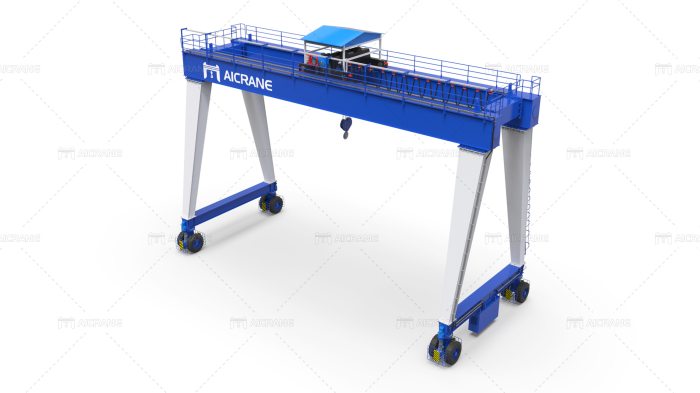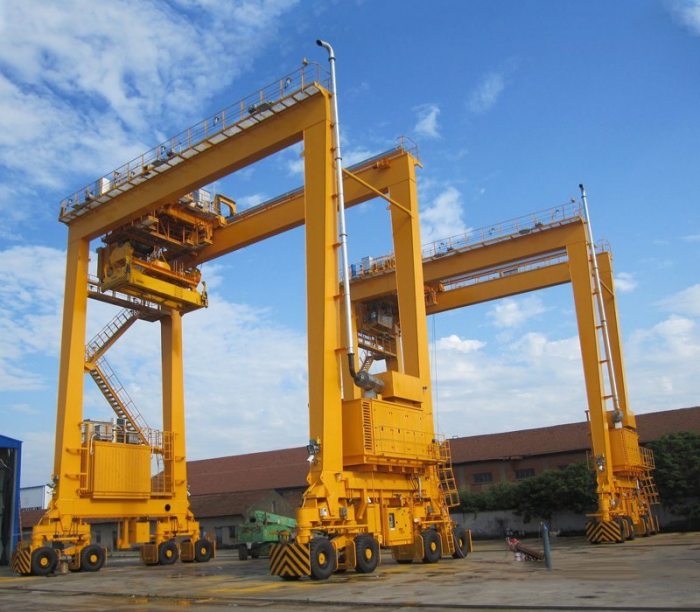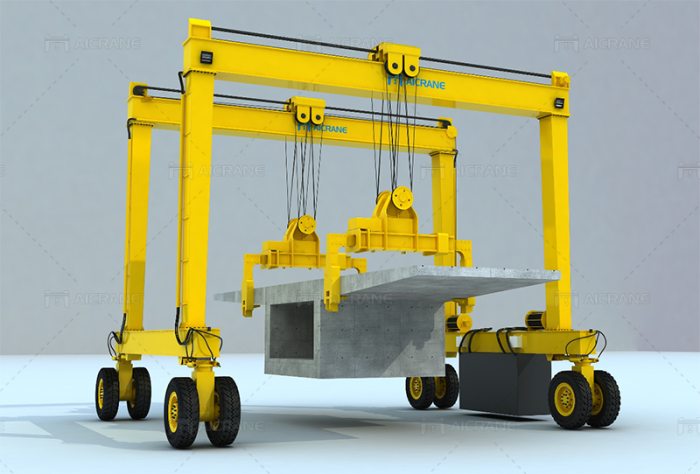Rubber-Tired Gantry (RTG) cranes have revolutionized the container handling process in ports and container terminals worldwide. These versatile and efficient gantry cranes are equipped with rubber tires, allowing them to move easily and quickly along the terminal yard. RTG gantry cranes provide efficient container stacking, retrieval, and transportation, significantly improving productivity in the logistics industry. This article explores the safety devices incorporated into RTG gantry cranes, the selection of container spreaders, as well as installation and maintenance practices for optimal performance.

Safety Devices in RTG Gantry Cranes
Safety is of paramount importance in container handling operations. RTG gantry cranes are equipped with various safety devices to protect personnel, cargo, and equipment. Here are some key safety features commonly found in RTG gantry cranes:
Anti-Collision Systems: RTG gantry cranes are equipped with anti-collision systems that utilize sensors to detect the presence of other cranes, vehicles, or obstacles in their operational area. These systems provide real-time information to the crane operator, helping them avoid collisions and maintain safe distances.
Load Monitoring and Overload Protection: RTG gantry cranes employ load monitoring systems that continuously measure the weight of the containers being lifted. These systems prevent overloading by alerting the operator or automatically stopping the lifting operation if the load exceeds the crane’s safe capacity.
Spreader Twistlock Monitoring: RTG gantry cranes utilize spreader twistlock monitoring systems to ensure that containers are securely locked onto the spreader. These systems detect any unlocking or abnormal movements, alerting the operator to take appropriate action before proceeding with container handling.
Emergency Stop Systems: Prominent emergency stop buttons are installed on RTG gantry cranes, enabling immediate cessation of crane movement in emergency situations. These buttons are easily accessible by the operator and provide a quick response to any hazardous conditions or events.

Container Spreader Selection for RTG Gantry Cranes
Container spreaders are essential components of RTG gantry cranes as they securely attach to containers for lifting and transportation. The selection of the appropriate container spreader is crucial to ensure efficient and safe container handling. Consider the following factors when choosing a container spreader for RTG gantry cranes:
Size and Weight Capacity: Select a container spreader that is compatible with the range of container sizes and weights commonly handled in the terminal. It should have the capacity to handle the heaviest containers without compromising safety or performance.
Spreader Type: There are different types of spreaders available, including fixed frame spreaders, telescopic spreaders, and semi-automatic spreaders. Each type has its own advantages and considerations. Consider the operational requirements and efficiency of container handling when choosing the appropriate spreader type.
Safety Features: Ensure that the container spreader has integrated safety features such as twistlock monitoring systems, anti-drop devices, and secure locking mechanisms. These features enhance safety and prevent accidents during container handling operations.
Installation and Maintenance of RTG Gantry Cranes
Proper installation and regular maintenance are crucial for the reliable and safe operation of RTG gantry cranes. Here are key considerations for installation and maintenance practices:
Installation: Follow the manufacturer’s guidelines and recommendations during the installation process. Engage qualified professionals with experience in crane installation to ensure proper alignment, structural stability, and secure anchoring of the crane.
Routine Inspections: Conduct routine inspections of the RTG gantry crane to identify any signs of wear, damage, or malfunction. Inspect the structural components, electrical systems, tires, brakes, and safety devices. Regular inspections allow for early detection of issues, reducing the risk of accidents or downtime.
Lubrication and Maintenance Schedule: Adhere to a regular lubrication and maintenance schedule as prescribed by the manufacturer. This includes lubricating moving parts, checking wire ropes for wear and tear, and inspecting electrical systems for any signs of damage or loose connections. Implementing a comprehensive maintenance program ensures optimal performance and extends the crane’s lifespan.
Operator Training: Proper training and certification for RTG gantry crane operators are essential to ensure safe and efficient operation. Operators should be familiar with the crane’s controls, safety features, load limits, and emergency procedures. Regular refresher training keeps operators up-to-date with best practices and enhances their ability to handle challenging situations.
RTG gantry cranes have significantly improved container handling efficiency in ports and container terminals. By incorporating various safety devices, such as anti-collision systems, load monitoring, and emergency stop features, RTG gantry crane machines prioritize the safety of personnel, cargo, and equipment. Selecting the right container spreader based on size, weight capacity, and safety features further enhances safe and efficient container handling. Proper installation and regular maintenance practices are crucial for optimal performance and prolonging the crane’s lifespan. RTG gantry cranes continue to be indispensable assets in the logistics industry, enabling smooth and streamlined container operations in ports worldwide.
